 Leading Blog | Posts by Month |
 Leading Blog | Posts by Month |
12.31.18

LeadershipNow 140: December 2018 Compilation
See more on 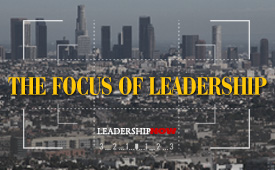 
Posted by Michael McKinney at 07:36 AM
12.27.18

Five Problems with Virtual Communication & What to Do About It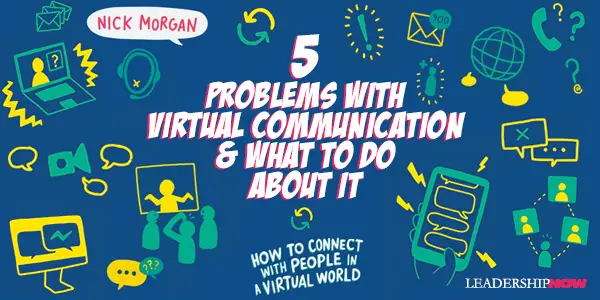
EVEN THOUGH WE have entered a new world of virtual communications, we still communicate in real-world ways that don’t always work in the virtual world. We’ve all sent an email or a text where we meant one thing and the recipient took it in a completely different way. They never saw the smile on our face, the touch of our hand, or the look of concern. There were none of the emotions that we take for granted in the real-world to guide them in the virtual world to a proper conclusion. We need new approaches and to become more conscious of what we are doing. We need to sharpen our communication skills in the digital world. We have to put the emotion back. Nick Morgan is here to do just that in Can You Hear Me? Nick Morgan is a master communicator and speech coach. And this book reflects that. His website Public Words is one of my favorite. The focus is public speaking, but the principles apply in most contexts including one-on-one conversations. Don’t miss it. The world of communication in the real-world and virtual world are very different with different dynamics. The same rules don’t apply. This leads to five major problems with virtual communication that need to be addressed. Problem One: The Lack of Feedback In the real world, there are two kinds of feedback: implicit and explicit. Implicit feedback is all of the non-verbal sounds, facial expressions, touches and body language that goes with conversation. Explicit feedback is the straightforward, unvarnished communication we get from others. In the real world, there is a mix of the two. But in the virtual world, implicit communication is almost nonexistent. In the real world, implicit and explicit work together to toughen the soft messages and soften the harsh messages. When we remove the implicit feedback from our communication, it’s little wonder we have misunderstandings, confusion, and often hurt feelings. (Emoji were introduced to help with this problem, but I find on important communications, an emoji doesn’t really convey the feelings behind our words.) Morgan says what has changed online is the nature of trust. “Trust in the virtual world is much more fragile, though perhaps easier to establish initially. But the big difference comes when something threatens the trust.” He explains: And feedback depends on trust. In face-to-face relationships where there is trust, one party may do something to screw up, causing friction, anger, and even a bit of mistrust to creep in. But if the connection is strong enough, the feedback begins. The issue will get thrashed out, the perpetrator will apologize, and trust will be restored. Indeed, once restored, the trust may be stronger than ever. Here are a few of Morgan’s suggestions to offer effective feedback in a virtual world: Virtual feedback should be appropriate and honest, but it doesn’t need to be cruel. “Leaven clarity with kindness.” Virtual feedback should be specific and focused on the relevant object, performance, or creation and not on the person. “A failed artistic performance doesn’t entitle you to judge the character of the performer. And general comments are far less useful—and far more damaging—than specific ones.” Virtual feedback should never be more about the giver than the recipient. We have all frequently seen where the feedback given “really concerns what the giver knows at some deep level to be the problem with his or her own work. If you’re going to offer feedback, you have to have enough security, distance, and impartiality to deliver an opinion that is truly helpful.” Problem Two: The Lack of Empathy Our virtual world robs us of real closeness and intimacy. “The distance provided by a virtual connection creates conditions where people are much more likely to behave badly to one another and are much less likely to be sympathetic to other’s feelings. There’s a lack of empathy.” When we are face-to-face, even the coldest of us find our mirror neurons firing when we are with someone who is experiencing an emotion. We laugh together, cry together, bond together. Put us in the virtual space, and empathy can’t work as well. The mirror neurons don’t fare as readily. We remain disassociated. The key lesson regarding empathy: “If you can possibly begin a relationship of any importance in person, you should do so. Period, full stop, end of discussion.” If you can’t, “do everything you can, especially early on, to be consistent, trustworthy, and transparent. In a virtual world, our stories are more important than ever. “Your online presence needs to meet four criteria: authenticity, clarity, comprehensiveness, and consistency.” Problem Three: The Lack of Control The virtual world is unforgiving. Online, “we hold others to rigid standards of behavior and are much less forgiving. In virtual space, this double standard is particularly compelling. If you behave badly, it’s because you’re a troll, and your mother and her mother before you, back a thousand generations. These feelings are not logical, but such is the nature of virtual relationships. Lacking emotional depth, we substitute brittle, intellectual, standards.” We don’t have control over what others say about us and others. And we rarely forgive inconsistent online behavior. So we need to be intentional about who we are and be consistent with that image. Decide now who you will be. Take control of your online life by creating a personal values statement. As an example of the kind of transparency, control and consistency Morgan is talking about, is Chris Palmer. Palmer is an environmental filmmaker with a personal mission statement (which you can find at the bottom of this page) he published on his website. Palmer told Morgan that publishing it “has transformed my life. I use it to guide my daily activities. Instead of confusion, I have clarity. Instead of feeling overwhelmed, I feel in control. Instead of ennui, I have purpose.” How do people see you online? What do you stand for? How could a personal mission statement guide your interactions online? Problem Four: The Lack of Emotion The emotions that come naturally in face-to-face communications is almost nonexistent in virtual communications. “Every face-to-face communication is two simultaneous conversations: the content (what you say) and the body language (how you say it).” Both are essential and very different. And when we take the emotion out we get bored, nasty or both. We are wired to make an emotional connection with others. Emotions are a vital part of our communications, and we base our decisions on emotion. “And removing that natural, easy, unconscious emotional data stream, as virtual communication does surprisingly well, is particularly crippling.” The virtual space we’ve created is uniquely set up to make it difficult for us to conduct our human business in the way that we’ve done for thousands of years. We think we’ve created something convenient, cost-effective, and efficient. Instead, we’ve created something that this stultifying, expensive in terms of emotions and decision-making, and wildly inefficient. Because of this, we need to consciously create tools that replace the unconscious connection tools we have in the real world. This would include becoming “exceedingly conscious about taking turns and allowing others to do so” and signaling that you are nearly ready to stop talking. Mediating conversations becomes more important. Morgan also suggests ways to add a three-stage “temperature” check to your conference calls. Problem Five: The Lack of Connection and Commitment Virtual communications aren’t as satisfying and emotionally compelling as our real-world interactions. Take the emotions out and we feel alone. We need to create engaging approaches that combine both the virtual and real-world behavior that leads to commitment in the end. Research Lynn Wu of Wharton found that the “more that individuals used social words in their chat with colleagues, like ‘coffee,’ ‘lunch,’ or ‘football,’ the less likely they were to be laid off.” Of course, these online tools can be misused, so balance is required. Nevertheless, connection with others and job security are closely tied. A few ways to create commitment in the real-world work well online. People look to others for cues, so use social validation to push people toward commitment. Remember the golden rule of reciprocity. A “strong feeling of cooperation allows people to connect, commit, and support each other.” Always be consistent. Look for similarity. “Similarity builds rapport.” Tell stories. “The best way to get and hold someone’s attention is to tell a story.” In part two of his book, Morgan provides specific techniques for various digital channels of communication: email, texting, conference calls, webinars, chat sessions, and sales efforts. All contain helpful advice to avoid misunderstandings. Our virtual relationships are more fragile and “these weaker ties mean we inhabit a more toxic world. The research shows that negative conversations stay with us longer than do positive ones because of how we metabolize oxytocin and cortisol differently.” In the real world, we let our unconscious minds do the heavy lifting—and pick up on those implicit messages. In the virtual world, we don’t have that luxury. My journey into the online world to understand the virtual communicator has led me to understand how profoundly inhuman many ways of virtual communication are. Our very human job now is to learn to put the emotional and memorable back into this attenuated world that has sprung up around us. 
Posted by Michael McKinney at 09:31 PM
12.25.18

Hyperfocus: How to Take Control of Your Mind
THERE ARE LIMITS to our attention. There is only so much we can focus on at any given time. So it becomes critical what we allow in our attentional space if we want to get anywhere in life. (And heads up. Your attentional space shrinks as you age—but your mind wanders less.) When we try to cram too much into our attentional space, we experience attention overload. When we do that we forget things because we didn’t leave enough space for what we originally intended to do. What is going on in our attentional space is the subject of Chris Bailey’s Hyperfocus. Bailey shows us how we can use our limited attentional space intelligently and deliberately so that we can focus more deeply and think more clearly. Hyperfocus happens when we consciously expand our attention to fill our attentional space. It is when we are the most productive—and happy. So, how do we enter hyperfocus mode? Distractions are distracting because they are more attractive than what we are focusing on. We have to plan in advance to remove them. Distractions are costly. Put the phone down. Don’t check the emails. “It takes an average of twenty-five minutes to resume working on an activity after we’re interrupted, and before resuming that activity, we work on an average of 2.26 other tasks.” Not good. Our smartphones rob our attention probably more than anything else. Bailey offers this great advice: “Resist the urge to tap around on your smartphone when you’re waiting in line at the grocery store, walking to the coffee shop, or in the bathroom. Use these small breaks to reflect on what you’re doing, to recharge, and to consider alternative approaches to your work and life.” Reflection is one of the biggest gifts we can give ourselves. And then we have to deal with the natural wandering of our mind by continually and consciously refocusing. It also helps to plan to hyperfocus for a predetermined length of time. “Setting specific intentions can double or triple your odds of success.” Bailey has a whole chapter on taming distractions and offers techniques to help us with all of this.
Although your attentional space naturally shrinks as you age, study after study has shown that you can expand it through the practice of meditation. “Meditation involves continually returning your focus to a single object of attention—usually your breath—as soon as you notice your mind has wandered from it.” Breathing is the go-to because “the smaller the object of attention, the more your mind will wander, but the more you’ll expand the size of your attentional space as you focus on it.” Ironically, as important as it is to hyperfocus, we must also scatterfocus. That is direct our attention on nothing at all—but in a deliberate way. In scatterfocus mode, we are at our most creative and it also allows us to recharge. And because in this mode our mind spends most of its time thinking about the future which is good because we can set intentions and plan for the future. It also “enables us to better weigh the consequences of each decision and path.” “With hyperfocus you direct your attention outward; with scatterfocus you direct your attention inward.” In scatterfocus mode, you can capture ideas and actionable material. You can discover solutions to problems and connect ideas. It also serves to replenish our mental energy. Hyperfocus takes a lot of energy, and when we feel our attentional space contracting, we need to recharge our attention by deliberately entering scatterfocus mode. Scatterfocus mode is a great place to connect the dots providing you are collecting valuable dots in the first place. People become experts on particular subjects by accumulating and connecting enough dots related to them, in the form of experiences, knowledge, and best practices. With that in mind, it is wise to guard just what dots we are collecting on a regular basis. Some dots build us up, and some don’t. Defend your attentional space. It’s good to collect dots that add to our existing skills and knowledge, but it is just as important to collect dots that are unrelated to what we know. This often where new perspectives and breakthrough ideas will come from. “Every time you stop consuming trash, you make room for something useful to add value to your life.” Not surprisingly, a positive mood expands the size of our intentional space, and a negative mood shrinks it. Unhappy people take longer to refocus. Guard your thoughts. Hyperfocus can help you get an extraordinary amount done in a relatively short period of time. Scatterfocus lets you connect ideas—which helps you unearth hidden insights, become more creative, plan for the future, and rest. Together they will enable you to work and live with purpose. 
Posted by Michael McKinney at 12:25 PM
12.21.18

5 Distinguishing Traits of High-Performing Leaders
WHO WE ARE speaks louder than what we say. Respect for others is the cornerstone of high-performing leaders. Respect is demonstrated daily through skills that we can all learn and make a part of who we are. Through his experience as an executive coach, Fred Halstead has defined in Leadership Skills that Inspire Incredible Results, seven skills that when practiced yield meaningful results. You may not be an expert at all but you can get better at every one of them. Demonstrating respect is more about asking the right questions than being ready with answers. Halstead admits though that “asking questions—in particular, questions than can inspire clearer thinking, solutions, and action plans—is challenging, especially when we are used to just telling others what we know should be done.” But to succeed we must have teams that are self-reliant, who understand their purpose and can execute on that purpose. Asking questions and guiding requires real focus. It’s about our team’s success. “Those who truly want others to excel are the ones who also achieve the greatest personal success.” To demonstrate respect and quip others we need to practice these skills with others: 1. Become a Fully Connected Listener Listening shows respect and appreciation. Listening must come first. It requires patience. As Fran Lebowitz observed, “The opposite of talking is waiting.” Our natural desire to talk, judging others, our biases ego, and our business, all inhibit our inclination to listen. “The less we worry about appearing smart, the smarter we will appear to be by just listening and asking smart questions.” Listening is easier when we are curious. It’s easier too when you know and believe in your purpose for listening. More than just gathering information, “when you listen to someone, you learn how that person thinks, which provides insight into how you can use them most effectively on a project, team, or in the organization.” Listen for intent and observe body language. Much of what you need to know is communicated in this way. Respect others by taking a breath. “When we’re great listeners, we give others the gift of silence. We’re not in a hurry, so silence—time to think—gives the speaker the opportunity to formulate and express her best thinking.” 2. Ask Powerful Questions When you ask questions, you become more engaging and it creates bonds with others. It means they will want to listen to you. The right questions are important. “The right question is often a crystallizer. It helps put a bow of clarity around one’s thoughts.” It can help them to articulate their own thoughts and expand their thinking. Clarity questions are “What concerns you most about this?” “If there is one thing you could do to begin to resolve this issue, what is it?” “What are your instincts telling you?” Timing matters when you are listening. Ask when you need clarity. Great questions open the door to additional thought. “Is this the solution?” opens the door to additional thought but closes the door on the conversation. A better question would be “If there is one thing that would make this solution better, what is it?” Halstead helpfully provides examples of powerful questions to achieve specific goals. The response, “I have not thought about that” is one of the best you can receive from your questions. You’re giving the other person the opportunity to think about new solutions in a positive way. You also show respect for the person being asked the question. 3. Develop Other’s Best Thinking Great listening and questions lead others from “I don’t get it” to “I got it.” You bring out the best in others. “By helping others grow, you give them the opportunity to take ownership of their actions and the results.” That’s leading. Be forward-thinking—solution-oriented. “When leaders focus on what can be done, people are inspired to achieve more, especially when they think of and articulate what it is that they are going to do.” One of the best ways to inspire your team to follow you because of you rather than in spite of you is to acknowledge the things they do well. More than a compliment, by acknowledging someone you are “calling attention to a specific behavior or talent, and it comes without any type of extra modifiers.” 4. Wise and Thoughtful Delegation Delegating demonstrates that you believe in others and they often respond by “expanding their ability to do more and perform at a higher level.” As a leader, the more you put everyone in the sweet spots of their talents, including you, the greater the likelihood of achieving short- and long-term exceptional performance. Delegating wisely both develops and uses those talents Thinking we are can do it better, impatience, a lack of trust, a lack of clarity about the job to be done, all inhibit our desire to delegate tasks. And that’s on us. 5. Create Consistent Accountability A culture of accountability means that people will do—actually accomplish—what they say they will do when they say they will get it done. Accountability builds trust. What often holds us back from creating a culture of accountability says Halstead, is that we what to be seen as nice. But when seen properly, accountability is nice. Accountability builds others up. Like delegating, we think we could do better and so we don’t hold people accountable. But when we do, we might learn from how they achieve the desired result. And frankly, we lack faith in others. We don’t really believe they have what it takes to get the job done properly. If this is the case, Halstead recommends that we walk them through the process so they can see what it will take to get the job done. Also, remind them of the talents they have that will be useful in accomplishing the task. These five skills, when practiced consistently will help to inspire incredible results. The thread running through them all is “as you respect others and put the interests of others in a paramount position, our personal success thrives, maybe in ways that you could not imagine.” 
Posted by Michael McKinney at 03:25 PM
12.19.18

Questions Are the Answer
A PROBLEM OF OUR TIME—and perhaps every generation—is that we ask the wrong questions. The wrong questions divide us. Great questions break down assumptions and create possibilities. Simply put, better questions give us better answers. It’s all about the question. Great leaders are great at asking better questions. In the rapidly changing environment, we are in today, it is imperative. Our future depends on it. Until you ask different questions, you can’t move beyond the incremental progress most of us find ourselves in. Breakthroughs require different questions from the ones we’ve been asking. Decisiveness is a great quality but too often we charge ahead without really understanding the issue. We don’t get behind the issue. Better questions help us to get there. In Questions are the Answer, Hal Gregersen explains: The point is not to remain in constant questioning mode, always stepping back to rethink things instead of stepping up to make a decision and get on with life. But answering yesterday’s questions is not good enough at times when we are feeling stuck, or when innovation is imperative, or when change must happen more continuously. How do you get to the right question? Gregersen says that we can create the conditions in which questions thrive. To increase our odds of formulating better questions, we need to get out observe and network with the intention of exposing ourselves to new and varied viewpoints. And listen. When we stop talking we’ll be amazed at what we can learn. Our viewpoint could always be improved. Be intentional about it. We are rewarded and conditioned to have answers. We are not typically encouraged to ask. More often we passively collect information without learning to question the foundational concepts. Good questioners were encouraged to ask from early on in their childhood. “If we want to raise a generation of better questioners, we should try harder to influence what happens at home.” Intentionally fuel curiosity. Encouraging those “why” questions will fuel their curiosity and help to generate the “what if” questions that design better futures. As you advance as a leader “and have the opportunity to lead others and have much more impact, your focus has to shift to ‘making other people the smartest in the room, with good questions.’” Be comfortable with being wrong. Try being wrong more. “Questions don’t arise whenever we are wrong. It’s only on those rarer occasions when we think we are wrong. And for most of us, it’s only when we are practically hit in the face with how wrong we have been that questions start to get our attention.” Seek to question and improve your views. It makes sense to keep reminding yourself to admit and embrace being a little more wrong, goading yourself to stray into somewhat more uncomfortable environs, and compelling yourself to be more reflectively quiet. Immerse yourself in situations where you feel less right, less comfortable, or less compelled to speak, and your questions will multiply. Gregersen suggests we brainstorm for questions—not answers—to find new insights. That is, what better questions could we be asking about our problem? He calls them Question Bursts. There are two rules to this exercise—first, questions only. And second, no explanations or introductions. Just the questions please. And keep it short—four minutes is ideal. You’re trying to get people to look at the problem differently. You’re not trying to elicit answers but to get people to think differently. Question Burst exercises help to minimize and potentially overcome cognitive biases and eventually generate the breakthrough answers we need. “Asking the right questions is the only path to creating value—real value—at any level and in any role.” You have to actively support questioners because most organizations try to silence questioners. A leader who is secure enough to be questioned is a better leader. If as a leader you ask questions, you make it safe for others to do the same. Did you ask a good question today? 
Posted by Michael McKinney at 10:26 PM
12.17.18

What a Mechanical Shark Can Teach Us About Leadership and Innovation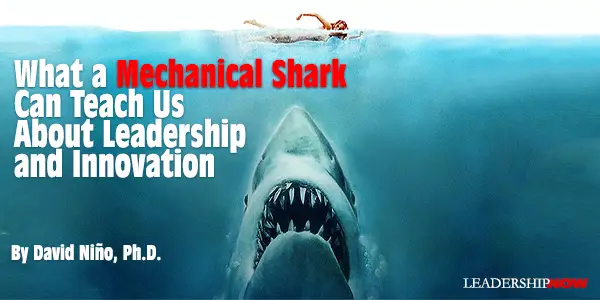
O But this wasn’t the film itself. It was a documentary on the making of the movie, all about the lengths that then 27-year-old wunderkind Steven Spielberg and his crew went to in creating a film that would define the summer blockbuster. I soon learned that this scene – one of the best known in the entire film – isn’t what Spielberg initially had in mind. In his original vision, viewers would be treated to a gory scene of the mechanical shark visibly attacking the unassuming woman. But “Bruce,” the mechanical shark, kept malfunctioning, and so the director had to find another way to tell his story. Spielberg could have insisted on the shot. After all, this was the scene he needed to “hook” the audience and keep their attention throughout the entire movie. He could have bawled out the engineers and technicians behind the mechanical prop, demanding that they somehow find a way to carry out his vision. But he didn’t. Instead, he brainstormed with the talented people around him and came up with a new vision – one that was just as compelling as the original, and with the added bonus that it would actually work. The result: One of the most memorable scenes in cinema history. This happened over and over again during the production of “Jaws,” with Spielberg and his crew forced to alter – or completely abandon – the director’s original vision to adapt to conditions on the ground. They had to improvise, making up major new scenes as they hit major new problems. As I watched the documentary, I was struck by how closely the story mirrored case studies from the business world, and how perfectly it illustrated the points I try to emphasize in the leadership and innovation class I teach at MIT. In business, we tend to mythologize innovative leaders as those who have a revolutionary vision and stick with it, no matter what. But, as Spielberg’s mechanical shark illustrates, the truth is frequently far more complex. In fact, an original, revolutionary vision isn’t innovation at all (and it certainly isn’t leadership). No, those fresh, once-in-a-lifetime ideas are examples of pure and raw creativity. And while these original sparks are surely important, they usually don’t stand up all that well to the pressures of reality. Anyone with experience with the unforgiving discipline of new product development can testify how exceedingly rare it is for even the best of ideas to emerge from that process unscathed. Creating something new is almost never a simple matter of dreaming a thing up and then building a physical representation of that vision. Nearly always, the process is an iterative one, full of trial-and-error, with more failures than successes. In one famous example, Thomas Edison had to teach himself thousands of ways not to make a light bulb before finding a way that worked. Innovation, then, is less about having original ideas than it is about being able to execute those ideas. It’s about delivering what customers will buy or use. Friendster’s founders had a creative concept, for example, but it took the minds behind Facebook to turn a similar idea into what is now one of the world’s largest companies. Henry Ford didn’t have the creative spirit that led to the invention of the automobile, but his innovative leadership resulted in a level of execution rarely matched in the history of manufacturing. In fact, even the assembly line was inspired by Ford’s observations of the meat slaughtering process, and how workers in that industry were organized to divide up the whole animal into pieces. Similarly, Spielberg borrowed from his idol, Alfred Hitchcock, in exploiting the terror of the unknown. One could, perhaps, cite these influences as dings against Ford’s and Spielberg’s creativity. But their willingness to lean on and learn from others’ ideas is a large part of what makes them such innovative leaders. If innovation is really about execution, then execution itself is really about problem-solving. Inevitably, problems pop up that stand in the way of a leader’s original vision: The bulb won’t light up; the customers won’t buy; the mechanical shark won’t work. The difference between ultimate success and failure is the ability to solve these problems. In fact, I would go a step further and say that the mark of an innovative leader is often his or her ability to redefine the problem – to see it in a new way that presents previously unseen solutions. Spielberg’s genius lies in his ability to recognize that his central problem wasn’t how to make a mechanical shark work, but rather how to terrify his audience. There’s a delicate balance at play here – what I sometimes call the “paradox” of leading innovation. On one hand, leaders must trust in themselves. They can’t be so wishy-washy that they’re willing to abandon an idea or strategy at the first hint of difficulty. But at the same time, they must be willing to surround themselves with talented people and place real trust in their teams to help them recognize problems and arrive at solutions. That’s what Spielberg did, staying up late with his crew night after night, devising new shots over beer and whiskey when the original storyboards had to be trashed. In the documentary, Spielberg said that all of the accolades and big-budget movies that came to him throughout the rest of his prolific career (one that includes directing credits on “E.T.,” “Jurassic Park,” and “Schindler’s List”) were made possible by the success of “Jaws.” And that success was due to his willingness to be flexible – to modify his vision through collaboration on his way to redefining the summer blockbuster forever. 
Posted by Michael McKinney at 10:32 AM
12.14.18

The Best Leadership Books of 2018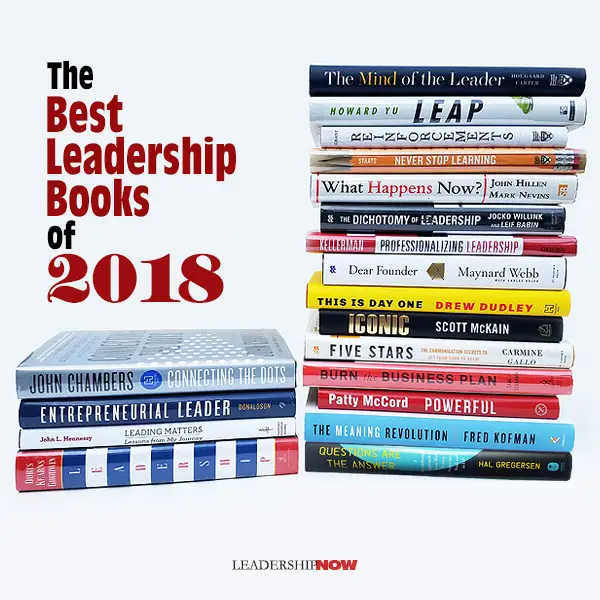
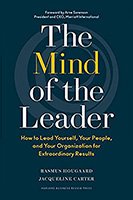 The Mind of the Leader: How to Lead Yourself, Your People, and Your Organization for Extraordinary Results The Mind of the Leader: How to Lead Yourself, Your People, and Your Organization for Extraordinary Resultsby Rasmus Hougaard and Jacqueline Carter (Harvard Business Review Press, 2018)  Leap: How to Thrive in a World Where Everything Can Be Copied Leap: How to Thrive in a World Where Everything Can Be Copiedby Howard Yu (PublicAffairs, 2018)  Reinforcements: How to Get People to Help You Reinforcements: How to Get People to Help Youby Heidi Grant (Harvard Business Review Press, 2018) 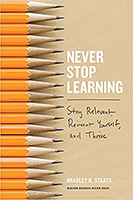 Never Stop Learning: Stay Relevant, Reinvent Yourself, and Thrive Never Stop Learning: Stay Relevant, Reinvent Yourself, and Thriveby Bradley R. Staats (Harvard Business Review Press, 2018) 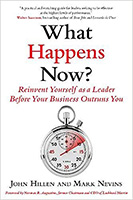 What Happens Now? Reinvent Yourself as a Leader Before Your Business Outruns You What Happens Now? Reinvent Yourself as a Leader Before Your Business Outruns Youby John Hillen and Mark D. Nevins (SelectBooks, Inc., 2018) 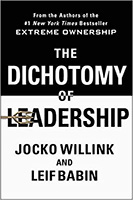 The Dichotomy of Leadership: Balancing the Challenges of Extreme Ownership to Lead and Win The Dichotomy of Leadership: Balancing the Challenges of Extreme Ownership to Lead and Winby Jocko Willink and Leif Babin (St. Martin's Press, 2018) 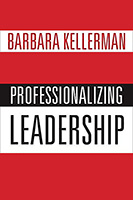 Professionalizing Leadership Professionalizing Leadershipby Barbara Kellerman (Oxford University Press, 2018) 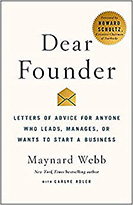 Dear Founder: Letters of Advice for Anyone Who Leads, Manages, or Wants to Start a Business Dear Founder: Letters of Advice for Anyone Who Leads, Manages, or Wants to Start a Businessby Maynard Webb with Carlye Adler (St. Martin's Press, 2018) 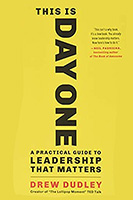 This Is Day One: A Practical Guide to Leadership That Matters This Is Day One: A Practical Guide to Leadership That Mattersby Drew Dudley (Hachette Books, 2018) 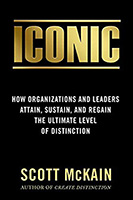 ICONIC: How Organizations and Leaders Attain, Sustain, and Regain the Highest Level of Distinction ICONIC: How Organizations and Leaders Attain, Sustain, and Regain the Highest Level of Distinctionby Scott McKain (Forefront Books/Simon & Schuster, 2018)  Five Stars: The Communication Secrets to Get from Good to Great Five Stars: The Communication Secrets to Get from Good to Greatby Carmine Gallo (St. Martin's Press, 2018) 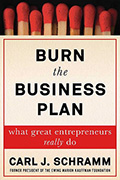 Burn the Business Plan: What Great Entrepreneurs Really Do Burn the Business Plan: What Great Entrepreneurs Really Doby Carl J. Schramm (Simon & Schuster, 2018) 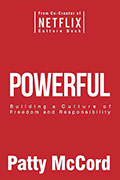 Powerful: Building a Culture of Freedom and Responsibility Powerful: Building a Culture of Freedom and Responsibilityby Patty McCord (Silicon Guild, 2018) 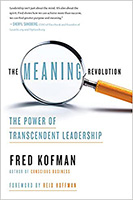 The Meaning Revolution: The Power of Transcendent Leadership The Meaning Revolution: The Power of Transcendent Leadershipby Fred Kofman (Currency, 2018)  by Hal Gregersen (HarperBusiness, 2018) Biographies: 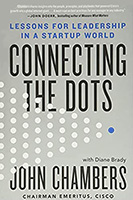 Connecting the Dots: Lessons for Leadership in a Startup World Connecting the Dots: Lessons for Leadership in a Startup Worldby John Chambers with Diane Brady (Hachette Books, 2018) 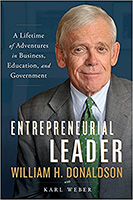 Entrepreneurial Leader: A Lifetime of Adventures in Business, Education, and Government Entrepreneurial Leader: A Lifetime of Adventures in Business, Education, and Governmentby William H. Donaldson with Karl Weber (Greenleaf Book Group, 2018) 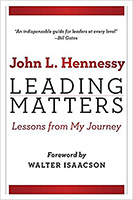 Leading Matters: Lessons from My Journey Leading Matters: Lessons from My Journeyby John L. Hennessy (Stanford University Press, 2018)  Leadership In Turbulent Times Leadership In Turbulent Timesby Doris Kearns Goodwin (Simon & Schuster, 2018) Related Interest:
Posted by Michael McKinney at 10:54 AM
12.12.18

Everything Begins with a Day One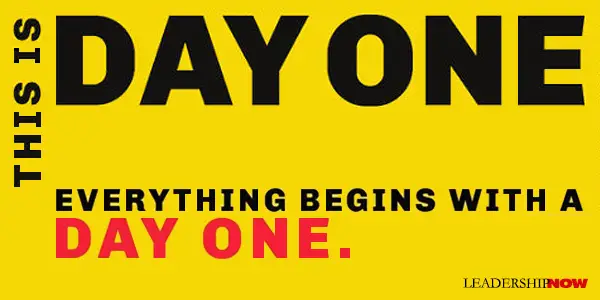
L This is Day One by Drew Dudley is about choosing to lead. Everything worthwhile in life begins with a Day One. “If you want to be a leader, chose to be a leader today. Repeat that choice every day. It doesn’t matter if you failed to do it yesterday or if you’ve done it every day for a decade: every new day begins with a recommitment to that choice.” And it’s a daily choice. With everything in our environment to distract us from that choice, to push us into being reactive rather than proactive, some days that choice will take a huge effort. But the payoff is big. Your most enduring legacy will very likely have nothing to do with your plans. The greatest impact you will have on the people around you and the organizations of which you are a part will almost always be a result of the unplanned consequences of your everyday actions. It’s the daily behaviors that add up to a successful life—to successful leadership. So we must plan to make a difference. Our leadership plan must revolve around who we want to be—our values. We must identify and define those values and then do something every day that embodies those values. “When you no longer must consciously align your behavior with your values—when it happens by instinct—you have created a ‘personal culture of leadership.’” Dudley has identified six values in his life that drive his behavior every day. Yours may be different. They are articulated through six questions that when asked in advance of your day can lead to a change in your behavior. His six questions are: 1. Impact—What have I done today to recognize someone else’s leadership? “Leadership recognized is leadership created. What if we all worked to create a culture in which the true measure of our lives is how many people smile when our name is spoken twenty years after they last saw us.” Answering this question “will create moments of impact that remind others they have mattered, do matter, and will matter in the future.” Let people know they are leaders to us. 2. Courage—What did I try today that might not work, but I tried it anyway? Courage is demonstrated through action. “Effective personal leadership is the willingness to honestly ask ourselves: ‘In what areas of my life am I settling? Leadership is having the courage to be honest with yourself about where in your life you are allowing yourself to settle and taking action to ensure you don’t do it for a single day longer.” 3. Empowerment—What did I do today to move someone else closer to a goal? We are responsible. “One of the reasons so few people put up their hand when asked if they are a leader is they’ve accepted a situation where the things that they are chasing in their life—the things they believe will make them happy—can only come from someone else.” A driver in New Orleans told Dudley, “We serve others whenever we help them move closer to one of their goals. For some people that might mean an educational goal, a career goal, or a goal related to their legacy. But let me tell you, the most important goals you can help someone reach are the goals related to their dignity. People need to feel seen, they need to feel understood, they need to feel connected to another person. Too many people in this world don’t have those goals met.” Acting for the success of others. 4. Growth—What did I do today to make it more likely someone will learn something? Expand your capacity. “Go too long without appreciable growth in your life and not only does it become difficult to see yourself as a leader, it become difficult to feel like you matter.” I liked this statement: “You can’t lead on a need-to-know-only basis. You can fix things, you can maintain, but you can’t lead.” We must continually expose ourselves to the new and uncomfortable. “It’s not enough to be supportive when you see opportunities to help people, you must be a catalyst for creating those opportunities and forgiving others the tools to create them for themselves. Forget power, influence, and control: make people feel like they’re better when you’re around and they will follow you anywhere.” 5. Class—When did I elevate instead of escalate today? We can choose our response. We don’t have to operate on autopilot. “Class is elevating a situation when your instincts push you to escalate, when it would be easier to escalate and when you have every right to escalate. The difference lies in your goal for the resolution of the situation: elevating means trying to succeed, escalating means trying to win.” Treat people better than they deserve to be treated. 6. Self-Respect—What did I do today to be good to myself? “The fact that we have the rest of our lives ahead of us is the biggest reason we don’t do things today that will make the rest of our lives better.” Plan failure into your plans. It’s inevitable. “The most extraordinary leaders I’ve known are the ones who are best at healing.” Only hurt people hurt others. “It means leaders have got to forgive and leaders have got to heal. If we don’t evict the things living rent free in our heads, we will carry them with us and one day use them as weapons against those we care about most.” The last section of the book is a workbook of sorts to help you define your own values and create your own questions based on those values. This is Day One will help to see leadership as a responsibility everyone has. It’s a choice. We can build a community of leaders one day at a time. 
Posted by Michael McKinney at 10:37 AM
12.07.18

Iconic: How to Attain the Ultimate Level of DistinctionS Creating distinction is based on four cornerstones: clarity (being precise about who you are), creativity (built on clarity, it’s about discovering a different approach—delivering creatively), communication (creating and delivering a compelling story), and customer-experience focus (create distinctive experiences for your clients). In the years since Create Distinction was published McKain realized there was another place beyond distinction. Becoming iconic. Once you achieve distinction, it’s time to become truly iconic. In Iconic: How Organizations and Leaders Attain, Sustain, and Regain the Highest Level of Distinction, he writes: Iconic organizations and leaders have become such universal symbols of distinction they are not only irresistible to customers in their marketplace, they compel interest and admiration across a wide spectrum. How do you attain iconic status? How do you maintain and enhance that status once you achieve it? And how do you regain that status if it has eroded in the marketplace? The answers to these questions are explained in detail in this book. Briefly, the process is based on the five factors of iconic performance that take an organization or a leader to a level beyond distinction:
Play Offense. “Every moment you are playing defense against the competition wastes a moment you could be innovating to make them irrelevant.” Play to your strengths and create accountability with clear expectations, measurement, feedback, and consequences. Make it special—leave a trail of tangibles.
Get the Promise and Performance Right. People evaluate us on promise and performance. “The challenge is that customers will always evaluate your performance based on the promise from their point-of-view … not yours.” Performance is in the eye of the beholder. “Iconic companies find a way to accelerate their promises while improving their performance to a public that has already become predisposed to expect their excellence.”
Stop Selling. Build a relationship. “Appeal to the aspirations of your customers and prospects. Then invite them to savor the experience that they desire through your product or service.” Think less like a professional and more like a rapper—let it flow!
Go Negative. This may seem a bit counterintuitive. Know your weaknesses. “Iconic companies are obsessed with learning what they did wrong, so they can change the behavior—or process—that created the unpleasant experience in the first place.” Check your culture. It may be holding you back from iconic status. “Don’t be satisfied with satisfied customers. See to have amazed, thrilled, and overjoyed followers.” Go negative doesn't mean a negative attitude. Instead, develop a defensive pessimism. “Defensive pessimism is examining what has gone—or could go—wrong, so you take the necessary steps to prevent it from occurring.”
Reciprocal Respect. Disrespectful behavior should never be tolerated. “What you tolerate you endorse.” How do you display respect to others? McKain recommends six ways: Don’t just hear—listen. Display open body language. Don’t nitpick. Show how you’re following up. Don’t withhold praise. Treat others equally and with sensitivity. Obtaining, maintaining, or regaining iconic status requires brutal honesty. Think like a start-up. Have an innovative mindset and look at everything you do from a fresh customer-centric focus. Again be sure to examine your culture. “Until your culture is right internally—no matter the size of your organization—many of your external efforts won’t help.” Your efforts may just draw attention to what you’re doing wrong in the eyes of your customers. Everyone in the organization needs to be on board with providing an excellent experience. “All components of the company have to be aligned internally before they can expect results externally.” The examples McKain uses throughout really help to drive the lessons home and trigger the thinking necessary to implement them in your situation. By the way, McKain has a great set of five short videos on his Instagram page explaining each of the five factors. Here’s #4 on Going Negative. 
Posted by Michael McKinney at 03:23 PM
12.05.18

The Key to Effective Leadership: Mindsets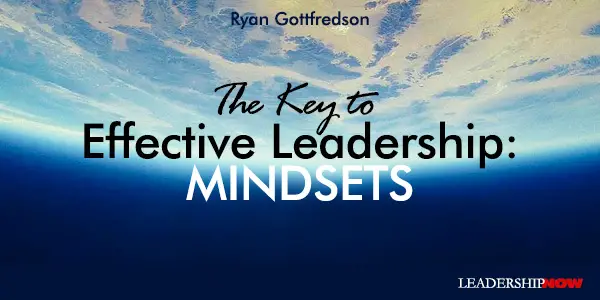
W To do so, consider four situations leaders can find themselves in:
Here is a table that shows two different leaders and how they each see and interpret these situations differently.
Who would you rather follow, Leader A or Leader B? Every group I speak to always says “Leader B.” But here is what is interesting, through a personal assessment I have done with over two thousand leaders and individuals, only 5% consistently operate like Leader B. What this hopefully demonstrates is that effective leadership is born not out of what leaders do or what behaviors they engage in, but first and foundationally in how they see and interpret the situations they find themselves in. So, what causes leaders to encounter the same situations, but interpret them so differently?
For example, consider a leader that has a subordinate that suggests that the leader could improve in some way. Depending upon the leader’s mindset, the leader could see that feedback as an indicator that the employee: (1) is questioning his/her leadership abilities and get defensive, or (2) cares about him/her and wants him/her to be as effective as possible. Thus, in this instance, the leader’s mindset drives how the leader thinks about the feedback, how likely the leader is going to learn from the feedback, and the manner in which the leader will behave in response to the feedback. Four Mindsets Necessary for Leadership Effectiveness If leaders’ mindsets are what drives their effectiveness, do you know what mindsets you need to develop to think, learn, and behave in the most effective way as a leader? Although mindsets are foundational to leaders’ effectiveness, most groups I speak to are unable to identify a specific mindset that is essential for leadership effectiveness. After learning about the power of mindsets and the foundational role they play in leadership effectiveness, I sought to identify the mindsets that drive effective leadership. As a leadership researcher, I scoured the academic literature, and I identified four sets of mindsets in largely four different areas of study (e.g., psychology, management, education, marketing) that have been studied for decades. While research associated with each set has repeatedly demonstrated that the mindsets influence individuals’ thinking, learning, and behavior, they have all be isolated from each other. Until now. I have pulled these different mindsets together into one framework to help leaders clearly identify the mindsets they need to develop to operate more effectively. Each set of mindsets represents a continuum from negative to positive as follows:  Every leader possesses a mindset that lies somewhere along each continuum, and the basic idea is that the more positive one’s mindset, the more effectively they are to think, learn, and behave in the situations that they encounter on a daily basis. Let me describe each set. Fixed/Growth
When leaders possess a fixed mindset, they seek to avoid failure, because, to them, failure means that they are a failure. Thus, those with a fixed mindset are primarily focused on looking good, and if something does not come easily or naturally to them, they have a tendency to give up. Leaders with a growth mindset, on the other hand, are primarily focused on learning and growing. They embrace challenges, see failure as an opportunity to learn and grow, and believe that success only comes through pushing through obstacles and difficulties. Closed/Open
Here is a great quote from Farnam Street: “Before you smugly slap an open-minded sticker on your forehead, consider this: closed-minded people would never consider that they could actually be closed-minded. In fact, their perceived open-mindedness is what’s so dangerous.” When leaders possess a closed mindset, they are primarily concerned about being seen as being right. As such, they seek to have their ideas supported, inclined to provide answers (as opposed to asking questions), avoid feedback and new perspectives, and see disagreement as a threat. All because they believe that what they know is best. When leaders possess an open mindset, they are primarily concerned about finding truth and thinking optimally. In order to do this, they ask questions, seek to understand, seek feedback and new perspectives, and see disagreement as an opportunity to learn. All because they believe that their perspective is limited and they can be wrong. Prevention/Promotion
Leaders with a prevention mindset are like a ship captain whose primary objective is to not sink. When this is the leaders’ objective, s/he focuses on ensuring no problems occur, limiting risk, and not “rocking the boat” (i.e., maintaining the status quo). Leaders with a promotion mindset are like a ship captain whose primary objective is to get to a specific destination. As such, the leader anticipates problems, sees risk as being necessary to reach the destination, and is willing to adjust operations to reach the destination. The difference between these two leaders is that those with a prevention mindset get blown about by the winds and the currents of the sea and end up in a destination not of their choosing, while those with a promotion mindset are willing to brave the winds and the currents of the sea to end up in a destination of their proactive design. Inward/Outward
When leaders have an inward mindset, they see themselves as being more important than others and are limited in their sensitivity to the feelings and emotions of those that they lead. And, when something goes wrong, they place the blame on others. When leaders have an outward mindset, they see others as being as important, if not more important, than themselves. And, when something goes wrong, they ask themselves: “Who am I being that their light is not shining.” Becoming a More Effective Leader Who would you rather follow, a leader whose mindsets are:
The effect of such leaders are just like they sound. Leaders with negative mindsets are constricting. Leaders with positive mindsets are expanding. What mindsets do you possess? Correspondingly, what type of leader are you because of your mindsets? Again, from my personal mindset assessment, I have found that only 5% of people consistently possess all four positive mindsets. If you are interested in learning how positive your mindsets are relative to thousands of others, I invite you to take my free personal mindset assessment. It will provide you with a personalized and comprehensive report to help you better understand each mindset set, what your mindsets are, and direction on how to improve your mindsets. In all: The key to being an effective leader is your mindsets.  
Posted by Michael McKinney at 12:19 PM
12.03.18

George H.W. Bush 1924-2018
G As a leader produced by the greatest generation—a term coined by Tom Brokaw to mean those who lived during the Great Depression and then went on to fight in World War II—Bush lead with moral authority. A grounded and humble man, he understood that character matters in leaders. In 2012, he told Diane Sawyer in an interview that “I've been very blessed, when you look around, compared to ... others. But you must feel responsibility to others. You must believe in serving others. I think that's a fundamental tenet of my life.” Bush lead in various capacities. Serving in World War II, he became the youngest combat aviation officer in the war flying Bush flew 58 combat missions in the Pacific. Shot down in 1944, he was awarded the Distinguish Flying Cross for his bravery in action. Shortly after leaving the Navy, Bush married Barbara Pierce. They had six children, one of whom died of leukemia before she turned four. His oldest son George Walker Bush was elected the 43rd President of the United States in 2001 becoming the second president to assume the nation's highest office after his father, following the footsteps of John Adams and his son, John Quincy Adams. Bush later said, “I don't know what would happen, I don't know where I'd be in life if I wasn't blessed with a lot of kids and grandkids and family, including, of course, Barbara. Family means everything to me. And we're blessed a with lot of 'em.... We take great pride in what they do and what their plans are for the future. And through—through their eyes, I think of life a lot.” He led in various capacities in his life as an oil company executive, CIA director, an ambassador to the United Nations and liaison to the People's Republic of China, and a congressman representing Texas. Most notably, he served two terms as vice-president under Ronald Reagan before becoming the forty-first president of the United States. (The first incumbent vice president to do so since Martin Van Buren in 1836.) Here is a selection of his thoughts that reflect his view and approach to life and leading: America is never wholly herself unless she is engaged in high moral principle. We as a people have such a purpose today. It is to make kinder the face of the nation and gentler the face of the world. His last words were to his son George W. Bush: “I love you, too.” Of Related Interest: 
Posted by Michael McKinney at 09:44 AM
12.01.18

First Look: Leadership Books for December 2018Here's a look at some of the best leadership books to be released in December 2018. Don't miss out on other great new and future releases.
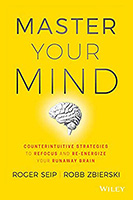
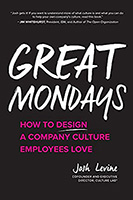
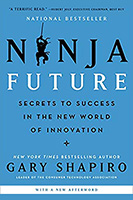

For bulk orders call 1-626-441-2024  Build your leadership library with these specials on over 39 titles. All titles are at least 40% off the list price and are available only in limited quantities. “Never trust anyone who has not brought a book with them.” — Lemony Snicket
Posted by Michael McKinney at 08:07 AM
|
BUILD YOUR KNOWLEDGE


How to Do Your Start-Up Right STRAIGHT TALK FOR START-UPS 
Grow Your Leadership Skills NEW AND UPCOMING LEADERSHIP BOOKS 
Leadership Minute BITE-SIZE CONCEPTS YOU CAN CHEW ON 
Classic Leadership Books BOOKS TO READ BEFORE YOU LEAD |
|